
Key task
Don’t stop watering lateflowering plants. Little rain gets through where foliage canopy is dense so a regular top-up can lengthening flowering time.
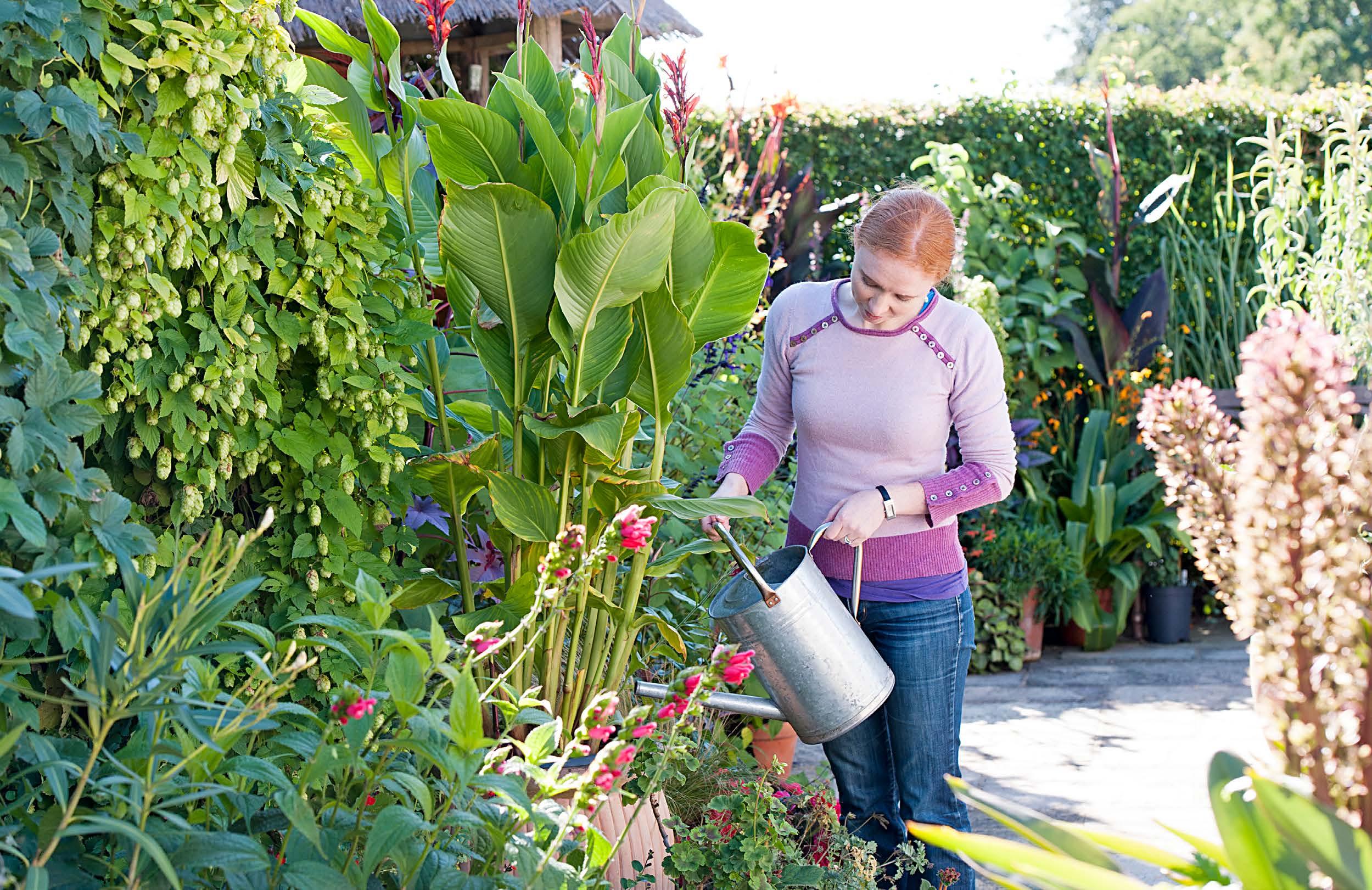
September
September is the most gentle and forgiving of months – a time for easing off the gardening throttle. There’s no need to rush around worrying about plants getting too big or seedlings getting devoured. This is a month to enjoy the harvest as veg such as tomatoes and chillies reach peak ripeness. It’s also a good month to rejuvenate the lawn and plant up some colourful spring bulbs.
Overview
Weather
■ While the soil is holding onto summer warmth and the shortening days and weaker sun mean that evaporation levels are decreasing, this is a good time for planting out perennials
■ Meteorologically speaking, this is the first of the autumn months and we start to notice shorter evenings. But summer will often linger, and it’s not unusual for September to have an average temperature similar to June’s
■ Average maximum temperature 16.5ºC
3 essential jobs
■ Plant out winter bedding
■ Take off shading or wash shade paint off greenhouse glazing
■ Divide perennials that have got too big
Wildlife to spot
■ Ivy bees emerge from hibernation in September and gorge on the nectar of ivy flowers
n Female garden spiders are building beautiful webs across shrubs and garden paths this month
n Common newts (also known as smooth newts) shelter beneath logs or stones ahead of hibernation. Out of water they can appear shrivelled, but this is perfectly natural
Sow
■ Hardy annuals
■ Japanese onions
■ Oriental leaves
Plant
■ Radishes
■ Spinach
■ Winter lettuce
■ Autumn- flowering heathers
■ Fruit trees and bushes
■ Ornamental cabbages
■ Potted cyclamen
■ Spring bulbs
■ Strawberry runners
Prune
■ Blackberries
■ Hedges
■ Hybrid berries
■ Summer- flowering shrubs –after flowering
■ Summer- fruiting raspberries
Harvest
n Autumn cabbages
n Autumn raspberries
n Chillies and sweet peppers
n Courgettes
n Kale
n Maincrop potatoes
n Onions
n Tomatoes
n Tree fruit, such as early apples and pears
This month’s Star plants
Welcome in September with our pick of plants that will fill your garden with a beautiful late show of flowers and foliage
1 Salvia ‘Amistad’
Deadhead this salvia regularly and it’ll bloom right into mid autumn. It’s excellent both in borders or containers. Grow it in a sheltered site with freedrainage to help it survive winter outside.

Flowers Jul-Oct Height x Spread 1.2m x 50cm
2 Gaura lindheimeri ‘The Bride’

The graceful, butterfly-like flowers of ‘The Bride’ are the perfect match for the seedheads of grasses this month. It’s dainty flower stems are long and thin and will weave in between other plants in the border. Grow in sun and light soil.
F May-Oct H x S 1m x 60cm
3 Hedychium densiflorum
‘Hassam Orange’
If you have space for big tropical leaves and bright colours in September, with this ginger you’ll get both. The leaves are like flags and the bright flowers are honey scented. Grow in full sun.
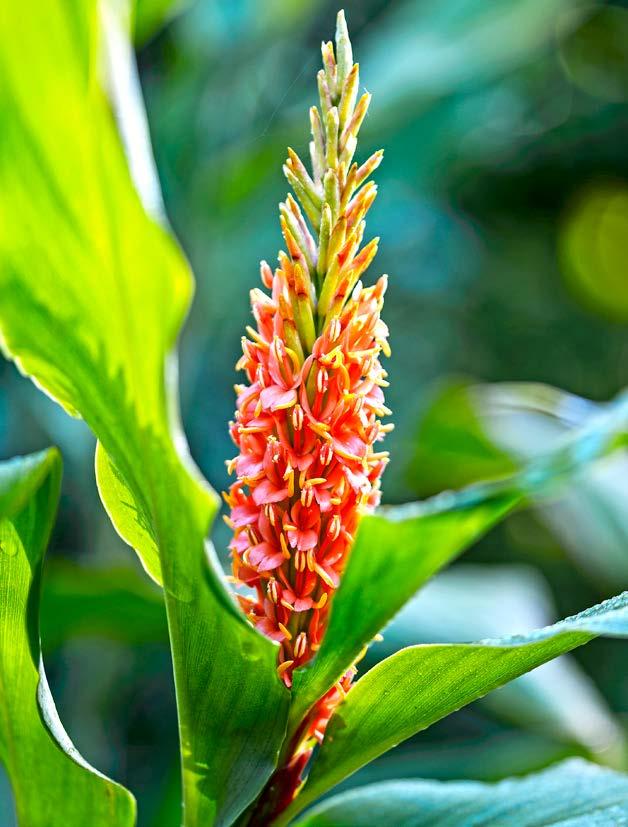
F Aug-Sep H x S 1m x 1m
4 Rudbeckias
Perennial rudbeckias such as ‘Goldsturm’ bring much needed colour to borders as summerflowering perennials fade. The daisy flowers look good combined with ornamental grasses or repeat-flowering roses. Grow in sun or part shade.

F Aug-Oct H x S 90cm x 45cm
5 Pennisetum advena ‘Rubrum’
The foliage of this grass is an autumnal dusky red, with arching red-purple flower spikes late summer to early autumn. Pot up and put somewhere welllit indoors before temperatures fall below 10°C.
F Ju -Oct H x S 90cm x 60cm

1
September
4 5 3 2
What to do now...
What to do now...
around the garden in your flower patch
Rejuvenate your lawn
5 min task
House plants that have been in the garden can go back on the windowsill but don’t warm them up too quickly – allow them to acclimatise
A few easy treatments now will help your lawn to recover from summer stress and keep it in good shape for months to come. Start by mowing the lawn, then scarify the surface with a wire rake or scarifying machine to remove all the accumulated debris. Next, dig out the weeds with a daisy grubber or narrow trowel, then sow lawn seed into any resulting gaps. Check whether the lawn edges are level –if there are dips, lift the turf back and add soil to raise it level. Finally, apply an autumn lawn feed to strengthen the grass for the winter.
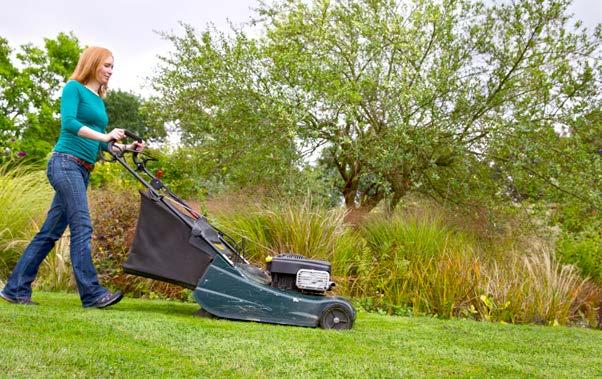
Protect tender plants
Protect tender plants by bringing them into the greenhouse for winter, now that nights are getting cooler and autumn weather is on the way. Clear plants of dead leaves, snip off any old flower stems and weed the pots before they go back in. Many plants, such as succulents, will cope with some cold conditions but will rot when it’s wet. The brightest spot in the greenhouse is the ideal place to keep them through winter.



Plant crocuses
Plant up pots of crocus corms now to give them time to develop strong root systems before spring. Choose a wide, shallow pot like this alpine pan and part-fill it with peat-free potting compost. Pots made of clay help with drainage, because the surface is porous. Use plenty of corms planted close together for maximum impact, but space them so that they don’t touch. Also make sure they are planted with the point facing up. Cover with a 6-8cm layer of compost, firm down, water and finally mulch with grit. Place in a sheltered spot outside.
Deadhead dahlias
Keep your dahlias flowering for longer by removing spent flowerheads as soon as they fade. For the longest possible flowering you’ll need to do this every few days. It can be hard to tell the spent flowers and the emerging buds apart, so look carefully before removing anything. The flowers that have gone over are pointed at the tip, while the emerging buds have a flat face. When removing dead flowers, cut the stem all the way back to a leaf joint, rather than just the flower.
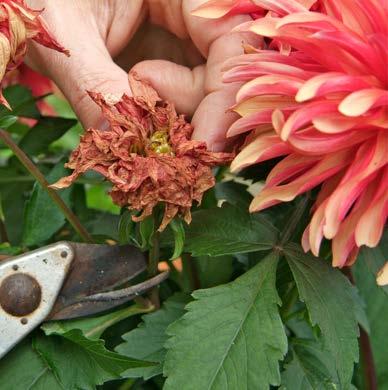
Top tip
As summer bedding plants come to an end, start pulling them out and replanting with polyanthus and violas for flowers in winter and spring
Plant out bedding wallflowers
Give privet hedges a trim

Cut privet hedges back now to thicken them up before winter sets in. Privet develops a loose habit when left alone, so the more you trim it, the thicker it gets. Use shears to trim back most of this year’s growth. Work from the bottom up and use a string line to act as a guide along the top to get it exactly level.
The ground is still warm and soil moisture is increasing, so now is a good time to lift spring bedding wallflowers and put them into their final flowering positions. Water them well the day before transplanting, lifting the entire rootball and planting as soon as possible, 20cm apart.


Plant so that the base of the lowest leaves are at ground level, to keep them wellanchored. They need sun and a light, free-draining soil.
Water again after planting, then mulch and protect against rabbits. They will start to flower in spring.
Tidy up climbers
Remove annual climbers such as morning glory as they die back. They can be vulnerable to catching and spreading fungal diseases that set in over autumn. These are annuals or tender perennials and are best grown from seed each spring. Cut the stems at the base, take off ties and untangle them from their canes.
Harvest late summer flowers
Other tasks to do...
■ Cut pelargoniums back and bring them indoors
■ Take hardwood cuttings
■ Pot up herbs to keep on a windowsill indoors
Fill your vases with the last of the summer perennials. Cutting the flowers helps to strengthen clumps for next year because they don’t like to use up energy producing seed. Sweet Williams are biennials but they will often flower again late in the summer and will grow as short-lived perennials if the flowers are harvested – they also attract pollinators to your plot. Leave some flowers to go to seed to encourage flocks of birds, such as goldfinches and tits, to visit the garden over winter.
W ILDLIFE FRIEND L Y
September
What to do now... growing your own

Crop of the month...
TOMATOES
Sow Jan-Apr
Harvest May-Sep
Tomatoes are good for the skin and rich in potassium. They may help reduce the risk of cardiovascular disease and could ward off some cancers. They may reduce the risk of heart disease and blood clots and lower cholesterol.
Full of flavour and easy to grow, it’s no surprise they’re a popular crop. Growing basil nearby may help improve the flavour of tomatoes, while borage may help to deter tomato hornworm. Eat the fruits raw or cook to boost the antioxidant levels and make them easier to absorb.
HARVESTING
Tomatoes can stay on the plant for two weeks. They lose flavour in the fridge. Tomatoes can be frozen whole, but go mushy, so it’s best to purée them.

OUR CHOICES
Cordon: ‘Shirley’; cherry:
‘Alicante’, ‘Golden Sunrise’, ‘Outdoor Girl’; beefsteak:
‘Costoluto Fiorentino’
IT’S ALSO TIME TO ENJOY
French and runner beans, beetroot, cherries, courgettes, peaches, peas and potatoes
Recipe of the month...
Plant some onions
Plant some autumn onion sets now on ground that has been cleared of summer crops such as carrots, French beans or lettuce. Rake the soil level and firm it down, particularly if the previous crop was deep-rooted. These onion sets will root in and shoot this autumn to overwinter as young plants, then the bulbs will mature early next summer.
1 Create a straight planting line in the soil of a veg bed that has been weeded and dressed with bone meal fertiliser.

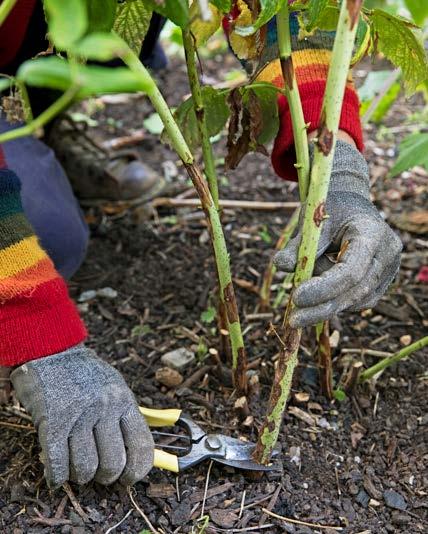
2 Space the sets along the line and use a trowel to plant them. Firm them in, leaving the tips of the bulbs just showing.
3 Water along the row, then remove the line and label the row. Protect with a layer of fleece to stop birds pulling out the crop, until shoots begin to show.
Cut back summer raspberries
It’s time to remove the spent canes of summerfruiting raspberries, while leaving in place a number of the new stems that emerged this year, so that they can provide fruit next season. The old stems will tend to be browner in colour. Cut them out at the base, along with any straggly new growth. Leave the strongest of the new canes in place, ideally leaving them at 10cm intervals.
Check whether apples are ripe
Assess whether your apples are ready to pick by choosing one with good colour for the variety then twisting it slightly in your hand. If that’s enough for the stalk to detach easily then it is ripe. You could also wait for some to drop off the tree and of course the absolute decider with dessert apples may be taking a bite to see if it tastes sweet enough to eat. If you pick too early the fruit won’t be sweet enough, so if they aren’t ready, leave them to pick later.

Harvest sage
Keep cutting fresh sage leaves to use in cooking. Sage is a delicious addition to many warming autumn and winter stews. It’s a great partner for squash and its fried leaves are a tasty garnish. If you have plenty of leaves, hang small bunches, tied at the base, upside down somewhere airy and dry. After a few weeks they can be stripped and stored in an airtight jar. Weed around the plant and give it a general fertiliser to help it recover. If the plant is getting tired, you can take cuttings in early summer to make new plants or grow it from seed in spring for a fresh supply of young leaves.
Top tip
Help pumpkins ripen by clearing away foliage covering the fruit so that the skin of the pumpkin is exposed to as much sun as possible
CHILLI JAM
September is harvest time for chillies. Transform your crops into a delicious and spicy chilli jam, perfect for enjoying with cheese or giving a kick to your lunchtime sandwich

50g red chillies, cut in half lengthways and de-seeded 1 plum tomato, peeled and de-seeded 2 or 3 dates, stones removed and chopped 1 garlic clove, peeled and crushed
10g ginger, grated
150ml vinegar
250g sugar
100ml water
Blitz the chillies, tomato pulp, dates, garlic and ginger, and add a little water to help create a paste.
Don’t forget to...
■ Lay mulch on veg beds
■ Cut off old leaves on strawberry plants
■ Plant spring cabbages
■ Dig up maincrop potatoes
■ Sow green manure
■ Harvest brassicas
In a heavy-bottomed pan, melt the sugar, vinegar and water over a gentle heat. Add the chilli paste and simmer before bringing to a gentle boil. Stir occasionally to stop the contents sticking to the base of the pan.
Cook down until most of the liquid has evaporated. Test by moving a spatula across the base – no liquid should be released on the other side. Carefully bottle up the hot contents into sterilised jars. Seal with a lid.
Note: Once a jar has been opened, it can be stored in the fridge for up to a month.
September
Key task
Harvest pumpkins and squash this month to make tasty soups and stews. Cut pumpkins with as long as stalk as possible when you harvest them

October
October can be a lovely month, with a soft light and midday warmth but days can suddenly turn cool – jumper one day, and coat the next. Although the growing season is nearly at an end, there is still plenty to do in the garden. It’s time to clean the greenhouse, tidy up canes, harvest the last veg and mulch borders, but it’s also a time to plant and think ahead to spring. Remember to plant your bulbs!
Overview
Weather
■ At the start of the month the sun is halfway into the southern sky at noon, but by the end of the month it rises little more than 30 degrees above the horizon
■ It is a month of weak sunshine and darker nights and we can see the first significant frosts too
■ Average maximum temperature 12.8ºC
3 essential jobs
■ Apply mulch to borders
■ Order bare-root fruit
■ Plant daffodil bulbs if you haven’t already. They are best planted this month. Tulips can wait until November
Wildlife to spot
■ Pipistrelle bats, which will spend this month mating and feeding themselves up ahead of hibernation – these are the bats most likely to use bat boxes
■ The nuthatch, which is increasingly seen in gardens, particularly in autumn and winter, when natural food sources dry up. You might see it climbing up and down a tree trunk, like a tree creeper, looking for insects
■ The last of the common carder bumblebees. Workers will be faded and worn by now, some almost bald
Sow
Indoors
■ Hollyhocks
■ Oriental poppies
■ Sweet peas (under cover)
Plant
■ Autumn bedding
■ Conifer hedges
■ Containerised roses
■ Garlic cloves
■ Onion sets
■ Spring cabbages
Prune
Outdoors
■ Green manure
■ Hardy broad beans
■ Hardy peas
■ Blackberries and hybrid berries
■ Blackcurrants (young plants)
■ Cotton lavender (santolina)
■ Lavatera – to tidy up uneven growth
■ Rosemary
■ Roses – to avoid windrock
Harvest
■ Autumn cabbages
■ Beetroot
■ Carrots
■ Parsnips
■ Potatoes
■ Squashes
■ Pumpkins
■ Swedes
This month’s Star plants
Take a look at our roundup of some of the most spectacular autumn plants, full of exciting colours to boost borders
1 Liriope muscari

Lilyturf is a wonderful plant for autumn, bringing unusual colour to shady spots. It will even thrive in deep shade, sending up spikes of purple flowers. A reliably tough plant for a tricky spot.
Flowers Aug-Nov
Height x Spread 30cm x 45cm
2 Chrysanthemums
Hardy chrysanthemums are valuable for late summer colour, flowering on until the first frosts. There’s a huge range to choose from whether you want something bright such as the pink ‘Talbot Parade’ (pictured) or something more subtle in white, yellow or even green.

F Sep-Nov H x S 1.2m x 50cm
3 Hesperantha coccinea
Hesperantha is a great autumn- flowering plant for a sheltered site, with delicate pink or red flowers on upright flower spikes. Plant in full sun for the best display of flowers. ‘Jennifer’ (pictured) has pale pink flowers and makes a fine cut flower.

F Aug-Nov H x S 50cm x 20cm
4 Japanese maples
Japanese maples are some of the best trees for small gardens. There are many compact varieties available and they are good for pots, making it easy to bring some spectacular autumn colour in to your garden. Leaf colour can range from bright yellow to fiery oranges and scarlet reds.

H x S 2-12m x 1-3m depending on variety
5 Euonymus europaeus

This shrub is a top pick, not just for its hot pink flowers but the crimson leaf colour and pinkwinged fruits that open to reveal orange seeds. It makes a striking focal point in the border in full sun or part shade, and provides food for wildlife.
F May-Jun H x S 4m x 3m
5
3 4 2 1
October
What to do now... around the garden
Prune off damaged wood
Check over woody plants in your borders, removing any damaged or dying back wood after the growing season. Use secateurs and long-handled pruners to cut back snapped and diseased shoots to healthy buds. It’s also a good time to shorten shoots that are in the way of other plants or growing across paths. If you suspect that any dieback is due to disease, separate the prunings and put them on the bonfire or in a municipal compost bag. Cut back into healthy-looking wood. Keep methylated spirits and a rag to hand to wipe the blades of your pruners between shrubs, to avoid spreading any fungal diseases.

Clean greenhouses inside and out
5 min task
Plant evergreens such as skimmia or sweet box in pots of soil-based compost to add interest to the patio or a doorstep
Collect up canes
Remove and collect bamboo canes that are no longer in use. Not only will it help tidy the garden, but you can use them again next year. Brush off any dirt, saw off rotten ends and store the canes outside so the frost can kill off any pests that may be lurking inside the hollow centres.

Mulch borders
Add a 5cm-thick layer of organic matter to your borders to improve the soil, suppress weed growth and conserve moisture. Tidy through the border first, cutting back any perennial stems that don’t give winter interest. Use a trowel to remove the roots of persistent weeds. Once the border is clean, cover with at least 5cm of composted waste, mushroom compost or rotted manure. Do this carefully by hand to avoid damaging plants in mixed borders and don’t let it build up against the stems of woody plants because it can cause rot.

Clear all the debris from greenhouse guttering to keep rainwater flowing efficiently. Also wash the outside of the glazing. Clean inside your greenhouse too – sweep the floor, wash pots and scrub benches and glazing bars with outdoor disinfectant to remove pests such as red spider mite and mealy bug, which hide in crevices over winter. Look out for hibernating snails in pots or attached to benches.

Other tasks to do...
■ Pull up finished annuals
■ Pot on rooted summer cuttings
■ Use pot feet to keep containers off the ground
■ Wrap up banana plants
Make leafmould
Make the most of the free delivery of leaves cascading onto your garden this autumn, converting them into compost that can be used as an organic soil conditioner and mulch. Collect leaves as soon as they fall, as they’ll contain more moisture and rot down more readily than very dry leaves. Always pick off leaves accumulating on alpines, evergreens, bedding and other plants, and prevent them blowing into ponds and water features by covering the water with netting. Sweep or rake up leaves where possible, making sure paths, steps and patios are kept clear as wet leaves are a slip hazard. Collect leaves from next door too, if neighbours don’t mind.
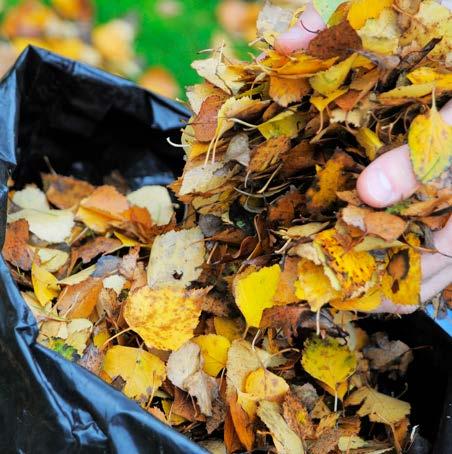
Top tip
Thick leaves will break down more quickly if they are shredded into smaller pieces, damaging them so that microbes can get to work
October
Plant...
...WOOD ANEMONES
Plant wood anemone rhizomes in a shady part of the garden, ideally in rich soil. Planted in drifts, these delicate, dainty plants are among the earliest to flower in spring, bridging the gap between snowdrops and bluebells. Cut dormant rhizomes into pieces 3-4cm long and clean soil off them. Soak if dry. Use a trowel to make 3cm deep indentations about 10cm apart in the soil and plant rhizomes horizontally 2cm deep.
Top tip
What to do now....
What to do now... growing your own in your flower patch
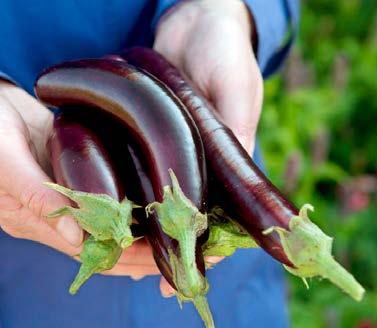

Harvest the last tender crops
Harvest the last of the fruits on all of your tender plants such as aubergines, chillies, courgettes and squash before they succumb to frosts. The foliage on these plants may well be dropping while the fruit is still fresh and firm. Pull the plants out after you’ve harvested, and put them on the compost heap.
Crop of the month...
...DAFFODILS
Bulbs planted in the ground are generally easy to grow, provided the soil and situation suit them.



Plant bulbs in groups, rather than singly. Space the bulbs a couple of inches apart in groups of 10 or 20 and plant the bulbs twice their height deep. Remember that bulbs planted in a lawn need foliage left intact for six weeks after the flowers have faded before you can cut it down. The leaves need to manufacture food with the aid of sunlight in order to stimulate the production of next year’s flowers.
Get hardy geraniums in shape now
Cut back hardy perennials such as the long flowering Geranium ‘Rozanne’ which is going over now having spread itself out all summer. This light tidying up of sprawling perennials will improve air and light around the other plants in the border and give space for winter and spring bulbs to emerge. Pruning now will also help to keep your hardy geraniums looking at their best until they start putting new growth again next spring.
Plant amaryllis bulbs

Pot up amaryllis (hippeastrum) bulbs to enjoy the impressive flowers in about eight weeks, in good time for Christmas. Keep them warm, but ideally move to a cooler spot when in flower to prolong the display. Choose the largest amaryllis bulb for multiple flowers. Then choose a pot that is just a couple of centimetres wider than the bulb. Half fill the pot with peat-free loam-based compost then position the bulb so the top half will be exposed. Fill around it with more compost, then water in well. Keep in a heated greenhouse in maximum light or a bright indoor windowsill works well, too.
Don’t forget to...
■ Move evergreen shrubs
■ Plant up some winter bedding
■ Overwinter tender plants indoors
■ Plant winter iris in pots
10 min task
Chop back the ferny shoots of asparagus when they have turned yellow. Cut to ground level and add to your compost bin
Recipe of the month...
PUMPKIN
Sow Apr-May
Harvest Sep-Oct
Harvest leafy salad crops

Cut just the outermost leaves of non hearting leafy crops such as chard, perpetual spinach, mustard and rocket to the base. More leaves will grow from the centre of plants and keep the middle intact. Thinning out plants will also help to improve the air and light around them. Keep them well watered to reduce the chance of the plant running to seed. Cold night temperatures can trigger flowering too, so put a fleece cover over the salad leaves to help protect the quality of the crop.
Don’t forget to...
■ Plant garlic
■ Sow broad beans for an early harvest next year
■ Harvest and store root veg
A TWIST ON RASPBERRY CHEESECAKE
The pumpkin really is a superfood. It may help protect against heart disease, hypertension, and prostrate cancer, while reducing cholesterol and improving your skin. It’s also packed full of vitamins A, C and E. Cut it into chunks and bake, roast or boil. Use in soups, stews and risottos or try in pies.

HARVESTING
Cut the fruits with the stalk intact when they are fully coloured and produce a hollow sound when tapped. Allow the skins to harden in the sun. Store in a frost-free room until March.
OUR CHOICES
‘Baby Bear’, ‘Becky’, ‘Jack Be Little’, ‘Jack O’Lantern’
Make the most of your autumn raspberry harvest with a delicious cheesecake

220g cottage cheese
200g full fat soft cheese
125g caster sugar
140ml soured cream
2 tbsp cornflour
1/8 tsp cardamom powder
1/8 tsp grated nutmeg
¼ tsp vanilla extract
3 eggs
150g fresh raspberries
few strands saffron
For biscuit base
250g digestive biscuit
50g butter, melted
Heat the oven to 160°C (fan). Crush the biscuits, mix in the butter and press the mixture into a greased, 20cm, loose- bottomed, round cake tin.
Whisk together cheeses and sugar, followed by soured cream, cornflour, spices and vanilla. Add the eggs one at a time, whisking the mixture inbetween. Fold in the raspberries, and crush and scatter the saffron. Pour onto the base and bake for an hour or until it is set with a slight wobble. Turn off the oven and leave the cake inside for an hour before removing. Let it cool then chill in its tin in the fridge overnight. Bring to room temperature and serve.
If planting new shrubs and perennials this month, check their eventual height and spread and leave enough room for them to mature
October
Key task
Plant up a pot with pansies, skimmia and winter heathers for a long-lasting stylish show of colour to brighten up the patio in winter

November
November is a month where colour comes from berries, rose hips, stems and blazing leaf colour. It can be bright and autumnal but it can also be freezing, which means that many jobs this month are about protecting the garden from the cold and also helping birds by putting out food. There are also late harvests in the veg garden and if the days look too grey, look ahead to spring and plant some tulips.
Overview
Weather
n November tends to be cold and wet. Upland areas are in the frontline of moisture-laden air from the Atlantic, while the west and north are wetter than the south and east.
n Maximum average temperature 9.1C
n Average November rainfall in Scotland –166.3mm; England, 88.2mm
3 essential jobs
n Finish clearing the summer’s crops
n Clean out nest boxes while they’re not being used
n Put cloches over salads
Wildlife to spot
n Redwings and fieldfares. These migrant thrushes from Scandinavia eat berries and windfall fruit
n Foxes, which don’t hibernate. This year’s young are like teenagers now, exploring new territories and foraging for food, which is becoming scarce as the season progresses
n Tits and finches, which are now starting to gather in ‘roving groups’ looking for food.
Sow
n Cyclamen – for blooms next winter
n Hardy broad beans – under cloches
n Hardy peas - indoors for pea shoots
n Salad leaves – on a well-lit windowsill
Plant
n Bare-root fruit bushes, hedging, roses, trees and shrubs
n Garlic
n Hellebores
Prune
n Indoor hyacinths
n Tulips
n Winter-flowering heathers
n Winter pansies
n Autumn-fruiting raspberries
n Bare-root roses (before planting)
n Climbing roses
n Deciduous trees and shrubs (except cherries and plums)
n Fruit bushes – once dormant
nGrapevines
Harvest
n Brussels sprouts
n Cabbages
n Carrots
n Cauliflowers
n Celeriac
n Jerusalem artichokes
n Kale
n Leeks
n Parsnips
This month’s Star plants
Showy flowerheads, wispy foliage, pretty fruits and classic flowers prove that there are still riches to be found in November
1 Miscanthus sinensis ‘Malepartus’
The flower plumes on this elegant grass will last well into autumn and it makes a lovely rustling sound on a breezy day. As the season progresses, the plant turns a lovely autumnal reddish brown. Flowers Aug-Sep Height x Spread 2m x 1.2m


2 Carex comans ‘Bronze Form’
This evergreen grass is a useful and attractive plant for winter borders and containers, providing year-round interest. It’s a versatile grass that’s happy in sun or shade and a good plant partner for winter bedding such as violas and heathers. H x S 20cm x 30cm
3 Camellia sasanqua ‘Crimson King’
We tend to think of camellias flowering in early spring but this variety produces its elegant flowers just as others are fading away. As an evergreen shrub, it also provides attractive year-round structure in a sheltered border.

F Oct-Nov H x S 2.5m x 2.5m
4 Roses for hips
Old roses and species roses will develop beautiful glossy hips if some flowers are left on the plant. Rosa ‘Alba Semiplena’ (pictured) is one of these, adding a splash of colour to mixed borders and a source of food for birds through winter.

F Jun-Jul H x S 2m x 1.5m
5 Hydrangea quercifolia
‘Quercus’ is the Latin for oak and ‘folia’ for leaves, so this is a hydrangea with oak-like leaves and they turn a sensational red in the autumn. Then in the summer you’ll be able to enjoy its large, cream coloured flowerheads.

F Jun-Aug H x S 2m x 2m
4 5 3 2
1
November
What to do now... around the garden
Look after cacti and succulents
Top tip
Now is the time to give your lawnmower a clean before putting it away for winter. Avoid getting it wet when cleaning. Safely store it somewhere dry
Lift and divide perennials
Spring-flowering perennials, such as pulmonaria, brunnera and centaurea, can all be split now to rejuvenate them and control their spread. Before replanting, weed the ground, rake in some bone meal fertiliser for strong roots and firm level.

1 Trim back the tatty old foliage or stems and dig around the plant before lifting it out carefully with its roots intact.

2 Divide by pressing two forks back to back into
the centre of the clump. Use the handles to lever the tines and split the clump. Use the same technique to divide them further.
3 Take the youngest outer sections and replant them, firming then well into prepared ground. Space them out so that each division has plenty of room to spread.
4 Soak the planted divisions and mulch with a 5cm thick layer of organic matter. Keep weed free and top dress with general fertiliser early in spring to encourage strong growth.
Give cacti and succulents as much light as you can for the winter, turning them around every few days on windowsills to ensure even growth. It’s crucial to keep them frost free and get the watering right in the dormant season to stop them rotting. Always allow the compost to dry out completely before watering as little as once a month, and never leave them sitting in water. Keep an eye out for any pests, checking regularly between leaves or under the rim of pots.

Tidy up ferns
ILDLIFE FRIEND
Leave seedheads for the birds
Allowing seedheads to remain on some perennials in borders will boost food stores for garden birds. The strong upright stems of echinacea, monarda, rudbeckia and agastache look great over winter, and are a good source of seeds for tits and finches. Taller teasels and grasses may need support, so use a few bare twigs strategically pressed into the ground to keep them aloft. Leave them until next spring and cut them back when new shoots appear at the base.
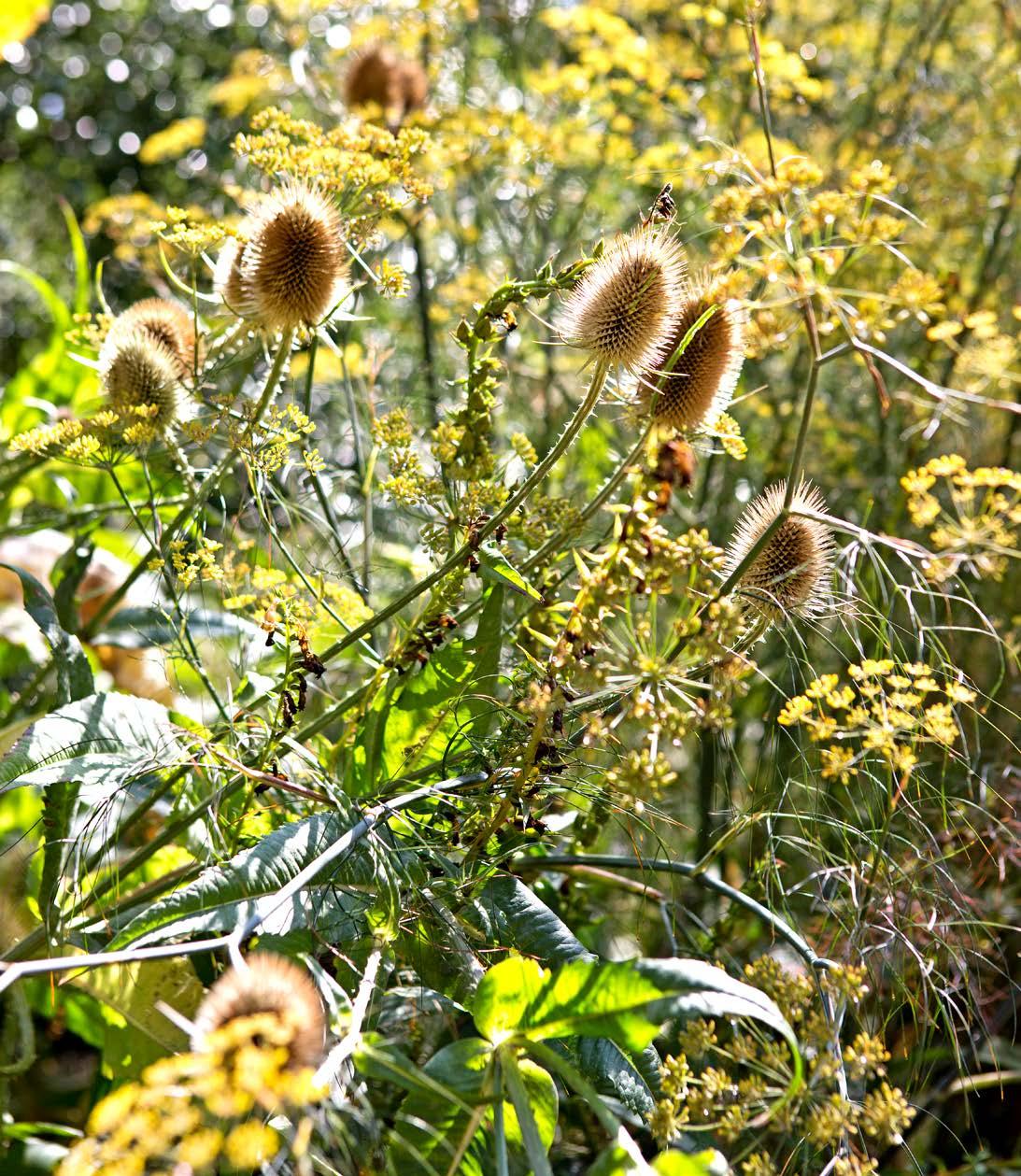
Make room for next year’s early spring growth by cutting back spent fronds on deciduous ferns. Most of the fronds will be brown by now, so trim them right back. Avoid cutting right into the centre, where next year’s fronds will be curled in tight, ready to unfurl. Clear all the debris away to help get air to the crown through winter. If it’s a tender species, you can use the old fronds to layer over the crown to give frost protection.
Other tasks to do...
n Turn on greenhouse heaters
n Wash pots and stack for reuse
n Repair supports and trellis
W
L Y
November
What to do now...
What to do now...
growing your own in your flower patch
Check your frost protection
Wrap up plants that are vulnerable to frost damage (this may be based on the weather forecast or for the whole winter), covering fully or just at the crown. Fleece tents give good protection for tender leafy evergreen shrubs such as bananas, exotic shrubs and tree ferns. A thick layer of mulch over permanently planted dahlias and cannas will help protect the roots. Good soil drainage in winter really helps as well. City warmth, natural geographical shelter and tree canopies offer some protection, too, so the cover you put in place may depend on where you live.
Plant tulips now for spring colour

November is the perfect month to plant tulips. Make a hole three times the depth of your tulip bulb, place it with the pointy end upright in the hole and fill back in. Planting now when the soil has chilled helps to avoid tulip fire, a fungal disease that thrives in warm soil. Avoid planting in the same position each year to keep them healthy. If you are adding tulips to mixed borders, mark where you’ve planted them with some grit to avoid damaging bulbs with later plantings.
Lift or protect dahlia tubers
Protect your dahlia tubers from frost damage by digging them up or putting frost protection over them in the border. If you grow dahlias somewhere mild and sheltered in well drained soil they will overwinter without damage, but, just to be sure, putting a thick mound of compost, leaves or bracken over the top will protect them. If you think they won’t survive, lift the tubers, brush off the soil and bed them into a pot of loose compost. Pop them somewhere frost free and don’t water them until next spring.
Crop of the month...
Pick kale regularly
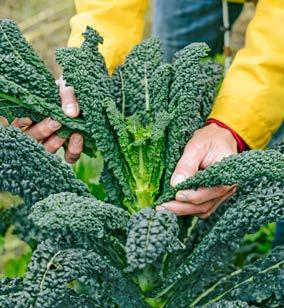
Harvest kale leaves now. Start with the outer leaves and pick from all your plants, taking a few leaves from each. The plants will last all winter if you harvest like this. The most tender leaves are in the centre, but if you take the whole crown there will be nothing left to crop except maybe a few spring shoots that will eventually grow from the stump. The best strategy in future is growing enough plants to do both.
LEEKS

Sow Jan-Apr
Harvest Aug-Apr
The Roman emperor Nero is believed to have eaten a bowl of leek soup every day, to improve his singing voice. Leeks are a good source of vitamins A, C and K. They contain the prebiotic inulin, which encourages good bacteria in the gut. They are antibacterial and antiviral. Fresh leeks are delicious sautéed in oil, in stews and soups.
HARVESTING
Dig up hardy crops as needed
Top tip
Before you plant bare-root roses, soak the roots in a bucket of water for two hours. This ensures the plant is well hydrated before planting
Don’t forget to...
n Lift cannas and store in a frost free place
n Take hardwood cuttings of shrubs
n Clear away annual climbers
Crops such as leeks and celeriac can be dug up when you need them. Celeriac tastes best when it’s fresh and can be left in the ground. Simply protect plants by laying a thick layer of straw over crops during cold weather. It can be harvested from October through to March, using a digging fork to carefully lift up each root. It’s flavour will get stronger the longer it stays in the ground.



Recipe of the month...
Don’t forget to...
n Pick Brussels sprouts
n Harvest the last apples
n Check stored potatoes and remove rotten tubers
SAVOURY SQUASH ROLLS
Leave in the ground until you’re ready to eat – mulch well to prevent the ground freezing OUR CHOICES

‘Carlton’, ‘Hannibal’, ‘Toledo’
IT’S ALSO TIME TO ENJOY Beetroot, cabbages, chard, parsnips, spinach,
This is the season to enjoy a range of winter squashes in some delicious savoury rolls

250g winter squash or pumpkin, peeled, diced and steamed
360g strong bread flour
1½ tsp salt
¼ tsp turmeric powder
¼ tsp pav bhaji spice mix (or garam masala if not available)
¼ tsp dried coriander
7g dried coriander
7g fast-action yeast
2 tbsp rapeseed oil
Butter, for brushing the tops of the rolls
Sesame seeds for sprinkling
In a bowl, mash the steamed squash. In another bowl, mix together the flour, salt, turmeric, pav bhaji spice mix, dried coriander, yeast and oil. Stir the mashed squash into the flour and spice mix, adding a little water to bind it into a dough. Knead the sticky dough for 10 minutes, then place in an oiled bowl to rise for about 1 hour. Once the dough has risen, remove from the bowl and place on a floured surface –knead the dough for a few minutes. Make equal-sized balls and place on an oven tray, then let them prove for a further 30 minutes. Bake at 190ºC (fan) for 30 minutes. Remove from the oven and cool on a wire rack. Brush the tops with melted butter and sprinkle sesame seeds over them.
November



























































